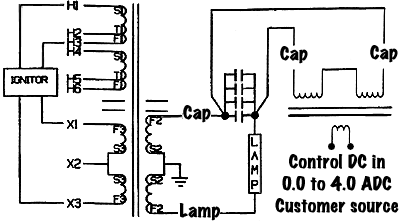Mercury Vapor Ballasts

UV ballasts are magnetic ballasts that are designed to drive tubular medium-pressure (ultraviolet) UV lamps. There are two types of UV curing lamps. The most common is the medium-pressure curing lamp with no metal additives. This UV curing light is available in arc lengths of 1 to 120 inches. The other type of UV cure light is a metal-additive-mercury-vapor UV lamp. The additives used in the metal halide lamps create changes in the curing lamp’s spectral output enhancing different portions of the ultraviolet spectrum. The UV lamp ballast initiates and controls the arc in both mercury and metal halide lamps. A metal halide ballast also provides a special waveform to maintain the arc in metal additive UV curing lamps. This is accomplished by providing an instantaneous high voltage to strike the elements within a mercury vapor lamp, creating a plasma that, once initiated, is sustained by the uv cure light ballast. Total wattages of up to 50 kilowatts are possible. Our UV ballasts and UV metal halide ballast both consist of lamp ballasts, capacitors and if needed an igniter.
The advantage of a magnetic ballast is that it is a constant-wattage ballast that it allows for wide variations in input voltage which only affect output wattage by only a few percent. These ranges can be customized to meet your application's requirements. Typical lamp ballasts have an output variation of only +/- 3% with an input voltage varying over a range of -15% to +10%. The constant wattage feature of a magnetic ballast is accomplished by a resonant tank circuit in which the lamp winding operates in a tuned magnetic saturation with a high voltage AC capacitor bank, such that voltage swings on the input side of the UV cure light ballast have a very small impact on the lamp current. An interesting feature of this tuned magnetic ballast is that the current-limiting capacitors can be switched (see schematic) in and out of the circuit to provide various UV curing lamps' power levels.
Metal Additive Ballasts
Metal halide ballasts are required for metal additive UV curing lights. In addition to needing a higher open circuit voltage a metal-additive curing lamp requires a special wave-shape to main the arc plasma. The metals inside the UV curing lamp create electrical noise in the metal halide ballast secondary circuit, which normally would cause metal halide lamps to extinguish during UV curing lights “warm-up” if a standard UV lamp ballast was used. The metal halide ballast uses a special bridge gap design to successfully shape the waveform and absorb this noise.
From the user's standpoint, the metal halide ballast has the same schematic as the standard uv cure light ballast. And can be used to operate a mercury uv cure light, but a magnetic ballast design for a mercury lamp cannot be used for a metal halide lamp.
Ultraviolet lamp ballast is available in sizes from 400 watts to 50kW in 50, 60, or 50/60Hz. Typically, the input power factor is better than ninety (90%) percent at nominal input voltage. UV ballasts are constructed using silicon grain-oriented steel, UL-rated copper wire, UL Class H insulation system, and impregnated with a unique epoxy varnish for maximum thermal transfer.

Standard Ballast
Controlled Ferroresonant Ballast

The controlled UV ballast offers a linear variation of output power from 40 to 100%. A standard lamp ballast switches capacitors in and out of the circuit to change UV curing light power as a step function. With a Controlled-Ballast, UV curing light power is adjusted by varying the conduction time on an inductor, which negates capacitance in the circuit allowing enhanced control of lamp current. UV Lamp current is sensed in a closed feedback loop circuit that can instantaneously respond to changes making the necessary adjustments.
Another advantage is that since the controls are on the secondary of the UV lamp ballast all the electronics are protected from power problems found on the primary side. A PLC interface is available to communicate with the ultraviolet lamp's ballast to vary lamp output. To protect all of the control circuitry from power problems typically found on the primary the control circuits are all located on the secondary of the UV ballast.
Features :
- Continuously variable output power from 40% power through 100% power
- Precise regulation, less than a 2% change in output power over an input range of +l0% to - 20%
- Low input current distortion is seen in SCR-controlled designs.
- No need for mercury relays.
- Very high input power factor. Typically better than 0.90
- Low lamp current crest factor, 1.5 typical
- High watt efficiency
- Controllable via a Programmable Logic Controller (PLC). A 4ma to 2Oma signal is preferred with 0 to 5 volt or 0 to 10-volt option.
- All components are pre-wired and tested at the factory
- Easy to wire. Just six wire connections need to be made to make the system operational
- Capable of running either a standard mercury lamp or metal halide lamps
- Secondary wave-forms are designed to improve lamp life
Saturable Reactors
If your application requires an accurate variation of UV curing lamp output power over a range of 30% power to full power, saturable reactors are available to provide a smooth, linear variation of UV lamp power.
